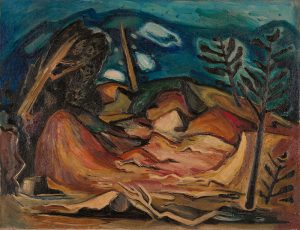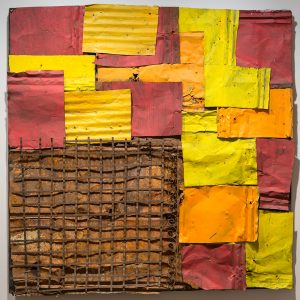Class Notes
Each year, the Ackland teaches thousands of UNC students in hundreds of courses across dozens of disciplines. We developed Class Notes so that you — and all of our visitors — can listen in and participate. Grab a gallery map from the front desk, and let this interactive guide lead the way!
American Studies, Fall 2023
Click the arrow below to listen to an Ackland lesson plan for a course called “This Place Called ‘The South.'”
Click the transcript button below to read the transcript of the audio file.
Welcome to class notes. My name is Elizabeth Manekin and I am the head of university programs and academic projects at the Ackland. Each year, we teach thousands of students in hundreds of courses across dozens of disciplines. We developed Class Notes so that you — and all of our visitors — can listen in and participate.
So, today you’ll be sitting in on part of an American Studies course called “This Place Called ‘The South.’” It’s a class about the South as a physical place, and also as an idea in history and in culture. Today we’re talking about Southern landscapes and the strategies visual artists use to depict and evoke them. We’ll be focusing on works of art by two African American artists in particular.
We’ll begin with a painting by Hale Woodruff, made around 1944. It’s located in Gallery 14, which you can find on your map. You can also just make a right after passing the elevator on your left; it’s in front you on that purple wall.
Once you’ve found it, take a look at the painting — not the label, but the painting — and consider what words come to mind immediately. Pause and actually do it. If you’re with someone, discuss it with them.
So, what are some of your words? I’ve heard storm, apocalypse… I’ve also heard flood, or underwater scene. Some students see hope in the white forms that dot the upper half of the painting. My word is often chaos.
After you’ve noted your gut reactions, pay particular attention to what in the painting inspired them. Describe the specific colors, lines, shapes you see. Go ahead and hit pause to actually do it.
You might have looked at the title already, but this painting is called Landscape (Mississippi Soil Erosion), and it was painted around 1944. In 1943, Woodruff received a fellowship and traveled through the deep South to document social and environmental issues. As a Black artist who’d lived all over the world, he was also interested in documenting the lives of Black people in the South. Thinking about social and environmental issues, I want to go back to the title: What are your associations with erosion? Where do you see erosion — or suggestions of its causes or effects — here?
Thinking about the themes of this course, what connections can you draw between the Southern landscape Woodruff depicts and the way he depicts it? Pause and think about it.
We’re now going to move to another work of art made by more contemporary American artist. It engages a Southern landscape through different materials and a shift in perspective.
Turn around and walk directly away from this painting but stop when the walls turn white — about four or five steps. Turn right and you’ll see a patchwork of red, yellow, orange, and rust-colored shapes ahead. That’s where you’re going. Gallery 12 on your map.
This is a work of art made by an American artist named Ronald Lockett. Before we get into the title or any information, I want you to look, just as we did in front of the Hale Woodruff. Focus on color and line. Pause to think and discuss. Now focus on material. Describe the materials and their surfaces. What associations do they inspire? Hit pause to actually do it.
Students often mention a weathered quality to the metal. They say it looks like roofing or reminds them of ramshackle huts. Maybe it’s been used before, maybe it’s lived another life.
Ronald Lockett collected this metal from around his home in Bessemer, Alabama. Bessemer was a mining center at one point, but it was also known for steel production. Lockett’s family lived there for generations and, like many Black families in the area, worked in mining, steel forges and, when those industries left, encountered fewer jobs and a slowed economy.
Where do you see evidence of Bessemer in this artwork? Hit pause and think about it.
You might think about steel and rust and the way they age overtime. There’s a sense of things abandoned here. Lockett selected his materials from what was around him — the material, too, is from a Southern landscape.
The title of this work is Remembering Sarah Lockett. Sarah Lockett was the artist’s great aunt, an avid quilter, gardener, and the matriarch of his family. Where do you see her presence in this piece? Knowing that this is a work meant to honor her, I’m curious: what do you imagine she was like?
And now thinking about all we’ve discussed, describe the Southern landscape this work of art depicts. Pause and think about it.
So, the Ackland’s collection holds over 20,000 works of art and they rotate regularly. And I’m afraid several works of art we used in this lesson are no longer on view. But I encourage you to look around on your own. How do you picture the South? What artwork can you find that resonates with your Southern landscape, as a physical place, or as an idea? Take time, actually do it.
And after you’ve lingered for a little while, class is dismissed! Hope you’ll join us again soon.

Hale Aspacio Woodruff, American, 1900-1980, Landscape (Mississippi, Soil Erosion), c. 1944, oil on canvas, 26 3/16 x 33 15/16 in. (66.5 x 86.2 cm). Ackland Fund, 2013.6. © 2024 Estate of Hale Woodruff / Licensed by VAGA at Artists Rights Society (ARS), NY.

Ronald Lockett, American, 1965-1998, Remembering Sarah Lockett, c. 1997, metal, wire, wood, and paint, 48 x 48 x 2 in. (121.9 x 121.9 x 5.1 cm). Gift of the Arnett Collection and Ackland Fund, 2010.52.5. © 2024 Estate of Ronald Lockett / Artists Rights Society (ARS), New York.
Image at top of page: Photo by Jon Gardiner/UNC-Chapel Hill
